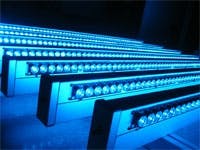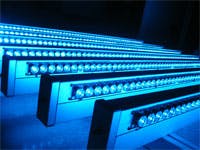Retailers use lighting in display windows to illuminate merchandise, attract attention, and even send a message about the quality of their store. To get the most impact, Dan Frering of the LRC says stores often use plenty of high-wattage accent lights to highlight mannequins and merchandise. “This creates visual interest and makes the merchandise stand out from the background,” he says.
This technique is effective but when used 12 or more hours every day, the energy consumption and costs can climb. The United States Department of Energy says lighting is the biggest energy expense for retailers, accounting for 37 percent of total energy use in US retail buildings. This could create opportunities for energy-efficient light sources such as LEDs.
Experiments show potential for LED lighting
The LRC field study was sponsored by the Los Angeles Department of Water and Power (LADWP) and used LEDs and drivers donated by Lumileds Lighting and Advanced Transformer Co., respectively. The aim of the study was to determine whether energy-efficient, colored window lighting could draw the interest of shoppers, reduce energy consumption in store windows, and maintain or improve retail sales.
The researchers tested different window display and lighting scenarios over an eight-week period and surveyed shoppers about the attractiveness, visibility, and eye-catching ability of the windows. Lighting inside the stores remained unchanged.
Frering says, “We designed the window lighting to create impact and contrast using color, instead of high light levels. This allowed us to reduce the amount of accent lighting and cut energy use.”
Savings and payback offer incentive
The potential savings and payback that can come from using alternative LED lighting designs may lead retailers to consider these new concepts. The LRC estimates that the average store can reduce power demand from lighting store windows by up to 1 kilowatt, saving 5,500 kilowatt-hours per year (based on 2,000 watts of window lighting and 14 hours of use per day).
Given current LED lighting system costs and estimated energy and maintenance savings, the typical system payback is less than two years.
“Helping our commercial customers save energy while increasing the effectiveness of their retail display lighting is a good thing,” said Lillian Kawasaki, assistant general manager of environmental affairs and economic development for LADWP. “As more lighting designers become familiar with the value of LED color enhanced display lighting, we can expect to see significant energy savings in Los Angeles and across the nation.”
However, a successful switch to LED lighting is not as simple as replacing one type of lamp for another in the same socket. LRC Director of Research Nadarajah Narendran says that many lighting applications can benefit from LEDs if the implementation is appropriate and takes advantage of the LED’s characteristics and performance. This often means finding creative design solutions. “Instead of trying to replace conventional technology with the new in a given application, it is better to identify alternate lighting solutions that exploit the strengths of the new technology, even if it breaks tradition,” he says. “That was one of our goals with this field study.”
Shoppers approve
After eight weeks and more than 700 surveys, the results were in: the colored LED lighting was a hit with shoppers. They preferred the colored LED window with a 30 percent reduction in power over the typical high-energy lighting design.
The survey results also showed:
- 74 percent of shoppers found the new lighting design to be eye-catching.
- 84 percent agreed that the LED display windows were visually appealing.
- 91 percent confirmed that the reduced accent lighting did not diminish the visibility of the window mannequins and merchandise.
Cutting the lighting power consumption further to 50 percent in each window resulted in no significant difference in shoppers’ opinions compared with the typical lighting, and a less-favorable opinion compared with the 30 percent reduction.
Sales data gathered by the retailer showed no significant change in sales at the three test stores during the study period, even with a 50 percent reduction in power consumption. Sales were compared with the same weeks for the previous year and with comparable stores owned by the retailer.






